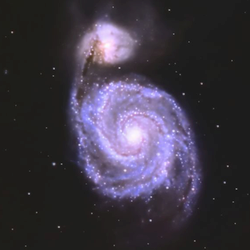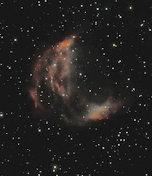Planetary Nebula
The Medusa Nebula
The Medusa Nebula is an intricate ghostly structure with tendrils of gas stretching like the serpentine hair of its namesake from Greek mythology. The Gorgon Medusa was a monstrous creature with living snakes in place of hair, and was known for her ability to turn anyone who looked at her into stone.
Click to read more. . .
April 5, 2025
324 words
2 min read
The Dumbbell Nebula
The Dumbbell Nebula, also known as M27, is a stunning cloud of gas and dust, located about 1,360 light-years away from Earth. One of the brightest and most beautiful nebulae in the night sky, it is especially known for its vibrant colors and distinctive shape, which resembles a dumbbell or an hourglass.
Click to read more. . .
November 1, 2024
275 words
2 min read
The Skull Nebula
The Skull Nebula is another example of the remains left by a dying Sun-like star that has cast away its outer layers in a cosmic farewell, leaving behind hot, glowing complex shells of ionized gas. I’ve shared examples before of these so-called planetary nebulae, but the Skull is a particularly appropriate nickname for such an object!
Click to read more. . .
March 22, 2024
414 words
2 min read
Rings in the Sky - Two More Planetary Nebulae
Here are two of the prettiest nebulae in the sky: the Helix Nebula (NGC7293) and the Ring Nebula (M57).
Click to read more. . .
November 10, 2020
289 words
2 min read
The Dumbbell Nebula
The Dumbbell Nebula M27 (also known as Apple Core Nebula) is a typical planetary nebula about 1300 light-years from us. It was the first such object to be discovered – by Charles Messier in 1764.
Click to read more. . .
September 1, 2020
231 words
2 min read
Open Clusters
Scattered mostly along the Milky Way are stellar groupings called open clusters, randomly shaped families of mostly young, hot stars that are all gravitationally bound to each other. Most stars are born in such clusters, containing anything between perhaps twenty to a few thousand stars. All of the stars in a given cluster are about the same age, having formed together from the same nebula.
Click to read more. . .
May 27, 2020
245 words
2 min read
The Owl Nebula and Surfboard Galaxy
The Owl Nebula (also known Messier 97) is a planetary nebula located approximately 2,030 light years away in the constellation Ursa Major. When William Parsons observed the nebula in 1848, his hand-drawn illustration resembled an owl’s head. It has been known as the Owl Nebula ever since. The nebula is approximately 8,000 years old. It is approximately circular in cross-section with a little visible internal structure. The nebula is arranged in three concentric shells, with the outermost shell being about 20–30% larger than the inner shell. The owl-like appearance of the nebula is the result of an inner shell that is not circularly symmetric, but instead forms a barrel-like structure aligned at an angle of 45° to the line of sight.
Click to read more. . .
February 27, 2020
192 words
1 min read

